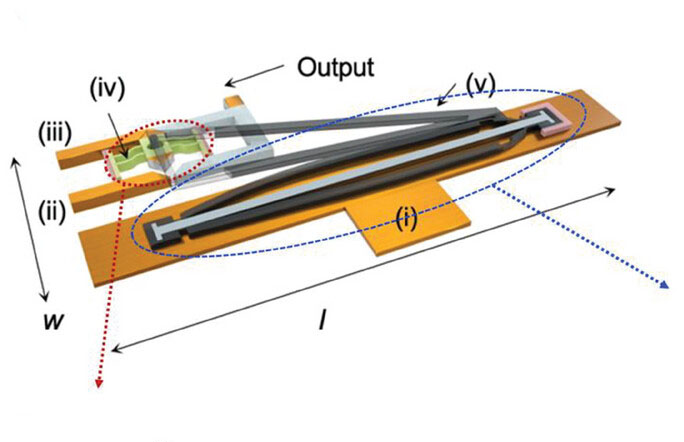| Mar 26, 2024 |
|
|
|
(Nanowerk Spotlight) In the field of computing, the electronic transistor has long been the dominant technology. Since its invention in 1947, this tiny device has become the foundation of modern electronics, enabling the digital revolution that has transformed nearly every aspect of our lives. However, despite its ubiquity and unparalleled success, the electronic transistor has its limitations. High power consumption, vulnerability to extreme environmental conditions, and a lack of direct interaction with external stimuli such as heat, force, and pressure have motivated researchers to explore alternative approaches to computation.
|
|
This is where mechanical computing comes in. Unlike electronic computing, mechanical computing relies on the physical manipulation of materials and structures to perform logical operations. This approach offers several advantages, including lower power consumption, increased security, and the ability to operate in harsh environments where electronic components often fail. Moreover, mechanical computing devices can be designed to directly respond to and process environmental inputs, opening up new possibilities for decentralized intelligence and adaptive systems.
|
|
Despite the potential of mechanical computing, progress in the field has been hindered by the ad hoc nature of existing designs. Most research has focused on the creation of simple logic gates, lacking the modularity and scalability necessary for more advanced applications. Additionally, many mechanical computing systems still rely on manual resets or electrical signals for input and output, limiting their autonomy and environmental responsiveness.
|
|
Now, a team of researchers from Shanghai Jiao Tong University has made a significant advance in addressing these challenges. In a recent study published in the journal Advanced Functional Materials (“Thermal Computing with Mechanical Transistors”), they introduce a novel mechanical transistor that combines a temperature-responsive material and a switchable structure. This innovative design enables the construction of complex logic circuits and memory storage, all without the need for electricity.
|
 |
| A Mechanical Transistor for Thermal Computing. a) Schematic of a mechanical transistor consisting of three input terminals (i)-(iii) and one output terminal for conveying temperature signals, a bistable actuator (iv), and a Kirigami-inspired thermomechanical sensor (v) fabricated from an asymmetric displacement amplifier composed of polycarbonate (PC) and invar alloy. The dimensions of l and w are 250 and 85 mm, respectively. (Image adapted from doi:10.1002/adfm.202401244 with permission by Wiley-VCH Verlag)
|
|
The mechanical transistor developed by the research team consists of three thermal input terminals and one thermal output terminal, along with a switchable component and a temperature-responsive material. The temperature-responsive material, made from a combination of polycarbonate and an invar alloy, changes shape in response to temperature variations. When heated, it elongates, and when cooled, it contracts. This shape change is used to control the state of the switchable component, which can snap between two stable configurations to represent binary states.
|
|
By arranging these mechanical transistors in various configurations, the researchers demonstrate the ability to construct a full suite of logic gates, including NOT, OR, AND, NOR, NAND, XOR, and XNOR. Remarkably, a single mechanical transistor can be reprogrammed to perform different logic functions simply by reconfiguring the thermal input sources, offering a level of flexibility and efficiency not seen in electronic circuits.
|
|
The mechanical transistors can also be combined to create more complex computing elements. The researchers show how two interconnected mechanical transistors can form a basic memory unit, capable of storing and retrieving information. Furthermore, by using a shape-memory polymer in the switchable component, they enable non-volatile memory functionality, meaning the stored information is retained even when the device is powered off. This integration of logic and memory within the same device paves the way for in-memory computing, a paradigm that promises to overcome the limitations of traditional computing architectures.
|
|
To showcase the potential of their mechanical transistors, the researchers construct an arithmetic logic unit, a key component of computing systems. Remarkably, their design requires only seven mechanical transistors to perform the same arithmetic operation that would typically necessitate 38 electronic transistors. This drastic reduction in component count highlights the efficiency and scalability of the mechanical computing approach.
|
|
Beyond pure computation, the researchers also demonstrate how their mechanical transistors can enable environmentally adaptive systems. By arranging two mechanical transistors in a sequence, they create a device capable of responding to ambient temperature changes to control the deployment of solar panels. This application illustrates the potential for mechanical computing to facilitate autonomous systems that can interact with and adapt to their surroundings, such as in aerospace, where electronic components may not be suitable due to extreme temperature fluctuations and radiation exposure.
|
|
While the development of this mechanical transistor represents a significant milestone in the field of mechanical computing, challenges remain. Heat dissipation and conduction losses are critical considerations for the scalability and practical application of these devices. Future research will need to address these issues to fully realize the potential of mechanical computing.
|
|
Nevertheless, the mechanical transistor developed by this research team offers a glimpse into a future where the boundaries between computation and the physical world are increasingly blurred. By harnessing the inherent properties of materials and structures, mechanical computing has the potential to usher in a new wave of adaptive, efficient, and environmentally responsive systems. While the electronic transistor will undoubtedly continue to play a crucial role, the emergence of its mechanical counterpart promises to expand the horizons of what is possible in the field of computation.
|
|

By
Michael
Berger
– Michael is author of three books by the Royal Society of Chemistry:
Nano-Society: Pushing the Boundaries of Technology,
Nanotechnology: The Future is Tiny, and
Nanoengineering: The Skills and Tools Making Technology Invisible
Copyright ©
Nanowerk LLC
|
|
|
- SEO Powered Content & PR Distribution. Get Amplified Today.
- PlatoData.Network Vertical Generative Ai. Empower Yourself. Access Here.
- PlatoAiStream. Web3 Intelligence. Knowledge Amplified. Access Here.
- PlatoESG. Carbon, CleanTech, Energy, Environment, Solar, Waste Management. Access Here.
- PlatoHealth. Biotech and Clinical Trials Intelligence. Access Here.
- Source: https://www.nanowerk.com/spotlight/spotid=64923.php





